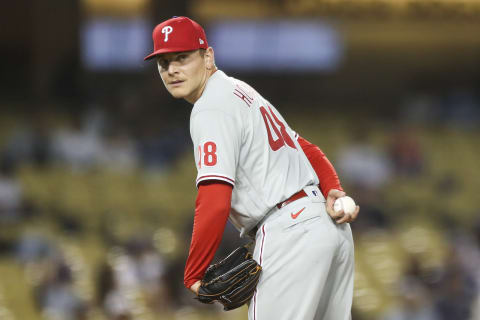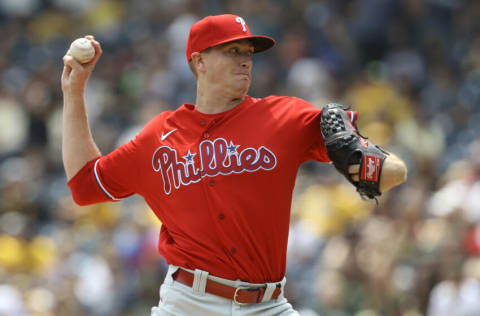Did the Phillies absolutely fleece the Rangers at the trade deadline?

One day, we’ll know for sure exactly how this trade between the Philadelphia Phillies and Texas Rangers turned out, who won and who lost, how each player performed for their new team, did any of these prospects amount to anything.
But at the outset, it’s looking like the Phillies did quite well for themselves.
In addition to getting starting pitcher Kyle Gibson, closer Ian Kennedy, and prospect pitcher Hans Crouse, Jayson Stark reports that the Rangers also sent $4 million to the Phillies.
So, the Phillies upgraded their rotation, bullpen, farm system, and continued their streak of never exceeding the luxury tax. The Rangers basically paid them to take one of their top prospects.
Feels like a solid win, yet Phillies fans seem unhappy with this trade.
The thing is, I’m not sure Dave Dombrowski would’ve been able to satisfy them this time around. Nothing short of Craig Kimbrel and Max Scherzer would have been enough at the deadline, and that’s quite an unrealistic pair for this team. Now that we know what the White Sox and Dodgers gave up to get pitchers of their caliber, it’s clear the Phillies weren’t going to be able to match them.
Ultimately, this trade was about upgrading now, while the Rangers are clearly rebuilding for the future. But from this vantage point, it feels like the Phillies got a lot without giving up too much.

Phillies get: Kyle Gibson, Ian Kennedy, Hans Crouse
Kyle Gibson (Starting pitcher)
Gibson has already made his first start for the Phillies, and he impressed his catcher and manager with the simple act of being able to pitch deeper than four innings into the game.
The bar is low!
But in all seriousness, Gibson is the kind of steady starter the Phillies rotation has desperately needed. For most of the season, it’s been Cy Young candidate Zack Wheeler, and a bunch of guys who can’t get out of the fourth inning.
Gibson has pitched five or more innings in every single start this season. Like I said, the bar is low, but Gibson has already cleared it.
Ian Kennedy (Closer)
Kennedy’s first closing opportunity didn’t go as planned – he gave up a two-run homer – but hopefully, it was just debut jitters. The 15-year veteran had a 2.51 ERA in 32 games with Texas before the trade, with 35 strikeouts over 32 /13 innings. He did strikeout two batters in his first Phillies appearance, so hopefully, this was just bad luck.
And hey, he can’t be as bad as Hector Neris and Co. have been in the closer role, right?
Hans Crouse (Prospect)
Crouse looks like a fun one. He tweets about Nick Foles, wiggles on the mound, and was being talked about as the Rangers closer of the future before the trade.
Hopefully, the Phillies will be able to develop him, since pitching prospects aren’t exactly their forte. But at the outset, he’s a great addition to their bare farm system.

Rangers get: Spencer Howard, Kevin Gowdy, Josh Gessner
Spencer Howard (SP)
It’s crazy how far Howard fell in just two seasons of big-league games. It doesn’t feel like he was their top prospect just last summer. Howard made his debut on August 9, 2020, and compiled a 5.81 ERA over 17 games between 2020-2021. His ERA was slightly lower this year, and his strikeouts were up, but so were his walks, and significantly so.
The Phillies have long struggled to develop homegrown pitching; there haven’t been many Cole Hamels over the last two decades or so. Was Howard not developing into the pitcher he was projected to be, or were the Phillies unable to help him, as they’ve been unable to help so many other top prospects? Likely, a bit of both.
Howard is the biggest piece in the Phillies side of the deal, and how his career turns out will be one of the biggest, if not the biggest factor in determining which side won this trade.
If the Rangers can figure Howard out, losing him will be rough for the Phillies. At the same time, there’s no guarantee he’d be good if he stayed.
Kevin Gowdy (Prospect)
Like Howard, Gowdy was a second-round pick. He’s been in the Phillies farm system since his drafting in 2016, and compiled a 4.62 ERA over 43 games. He missed the 2017 and 2018 seasons, and has been at the High-A level all season.
Gessner’s first appearance for the High-A Hickory Crawdads wasn’t a exactly a great first impression: five innings, four earned runs on five hits, two homers, and two walks. The good news about first impressions in baseball, though, is that they’re a small sample size.
Josh Gessner (Prospect)
Gessner comes to the minors by way of Sydney Australia, and rounds out this three-for-three all-pitchers trade package.
The 21-year-old has been in the Phillies system since 2019, and appeared in three games for them at the rookie level this season. He’s compiled a 1.17 ERA over that small sample size, and is a long ways away from the big show.
Phillies: Kyle Gibson’s debut included a promising message to fans. light. Related Story
